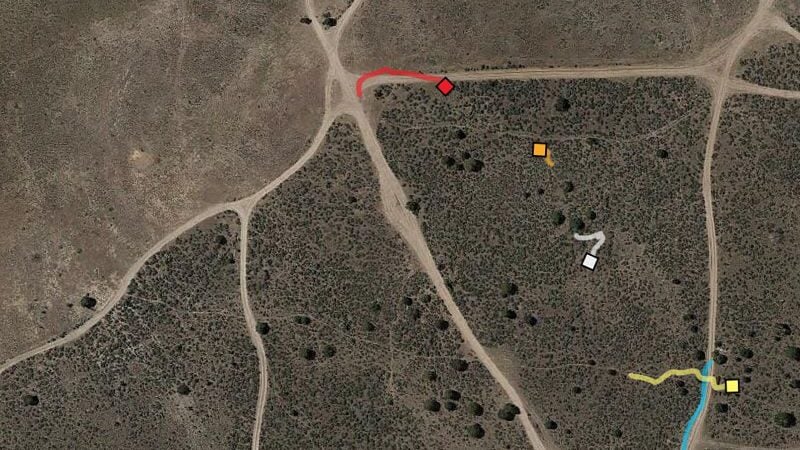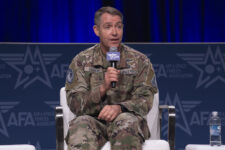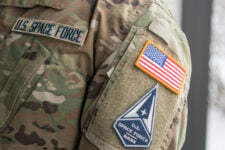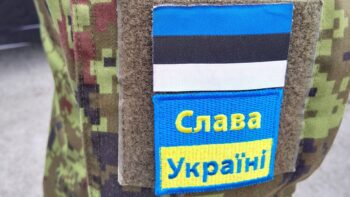
Up to now, the bulk of military needs for imaging to track moving targets on the ground has come from radar sensors on aircraft. (Image: IMSAR)
ORLANDO — The Space Force is circulating a first take on how new satellites equipped with sensors to track terrestrial targets as they move would actually operate and get that data to users — whether they be military “shooters” or intelligence analysts, according to Chief of Space Operations Gen. Chance Saltzman.
“We have written the first draft of our concept of operations for that. It is now floating around the Department of Defense and the IC [Intelligence Community] for comment and connections and make sure that we understand that. So, as the tech development is going through the NRO [National Reconnaissance Office] channels, the operational concepts are being developed by the Space Force. And then, we’re in continual collaboration to make sure they meet in the center,” he told reporters here Wednesday at the Space Force Association’s inaugural Spacepower conference.
“This is a new type of capability. It’s not completely the Intelligence Community supporting the [Defense Department]. It’s not completely a DoD mission without the help of the Intelligence Community. It’s this combination of the two,” he said.
This means that “data is going to be available to whomever needs it for their operational purposes. That may be an intelligence analyst sitting somewhere that’s going to do things that I don’t ever want to understand. And it may be data that goes to battle managers to put against a target and have a shooter engage a target,” Saltzman elaborated.
After years of debate, the Department of the Air Force, which provides civilian oversight of the Space Force, and the National Reconnaissance Office (NRO) are jointly funding and managing the effort to develop new space-based Ground Moving Target Indicators (GMTIs) — sensors that can track in near-real time objects of interest like PLA warships in the South China Sea or Russian tanks in Ukraine.
Current spy satellites operated by the NRO can provide snapshot pictures that show movement, of say a column of trucks headed to North Korea’s missile launching sites, after the fact, but cannot not persistently follow them in real time. The Air Force in the past has used planes to do that job, in particular the aging E-8 Joint Surveillance Target Attack Radar System (JSTARS) that currently provides targeting data to air-, ground- and ship-based weapons platforms. The service is retiring JSTARS, however, and intends to replace it in part with the new GMTI satellites.
Details about the planned new sensors are scant, but GMTI systems traditionally have been based on radars use a pulsing technique to discriminate moving targets from stationary objects and then clock their velocities based on their Doppler shift.
Under a deal struck earlier this year, the Space Force is developing the requirements for the new sensors and will oversee the acquisition program’s progress. NRO is doing the actual acquisition of the classified sensor payloads based on its own design.
Saltzman praised the collaboration on the effort with NRO, calling it “world class,” and noted that it’s “a lot easier said than done” given each side’s “mission boundaries.”
He further explained that there are a lot of moving parts that still have to be fleshed out, both from a technology angle and a concept of operations view. For example, he said, the Space Force is going to “build the ground infrastructure” to transmit data gathered from the new satellites.
“That’s going to require some some thought into how we do that effectively in terms of timeliness, etc.,” he said.
Another challenge is to “put the battle management operational concept together” for ensuring how accurate data gets to the right place at the right time for use by military commanders, Saltzman noted.
And yet another unresolved issue is how the Space Force will organize itself to deal with all of that, for example whether a new Delta [the Air Force equivalent of a wing] will be required.
“I think there’s still some tabletop exercising that needs to occur to figure out, you know, what are the key points that need to be addressed in order to answer that question in particular,” Saltzman said.
“But, you know, I think generally speaking, you would say there’s going to be some unit that has responsibility for managing the constellation, and all of the considerations with keeping it healthy and effective to support and collect data. And then there’s going to be some unit of action that is more of the receiver of the data and the connection to the combatant command structures that allow target engagement — so satellite operators and then battle managers, if you will,” he said.






















